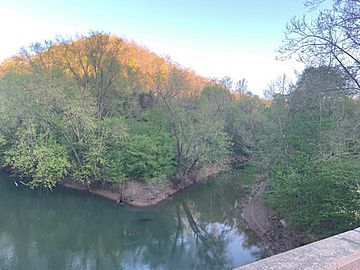Big Harts Creek facts for kids
Quick facts for kids Big Harts Creek |
|
|---|---|
|
Big Harts Creek empties into the Guyandotte River in Harts, West Virginia
|
|
| Other name(s) | Harts Creek, Big Hart |
| Country | United States |
| State | West Virginia |
| County | Logan and Lincoln |
| Towns | Harts, Warren, Spottswood, Whirlwind, Enzelo, Shively, and Halcyon |
| Physical characteristics | |
| Main source | Main Harts Creek Harts Creek Mountain, Chapmanville District, Logan County, West Virginia, United States |
| 2nd source | Smokehouse Fork Crawley Mountain, Chapmanville District, Logan County, West Virginia |
| River mouth | Guyandotte River Harts, West Virginia, Harts Creek District, Lincoln County, WV 38°01′45″N 82°07′50″W / 38.02917°N 82.13056°W |
| Basin features | |
| Tributaries |
|
Big Harts Creek is a stream in West Virginia. People often call it "Harts Creek" or "Big Hart." It flows into the Guyandotte River. This creek runs through Lincoln and Logan counties.
Contents
Where is Big Harts Creek?
Big Harts Creek starts in Logan County. Smaller streams flow into it, like Smokehouse Fork, Buck Fork, Big Branch, and West Fork. These are called its tributaries. The very beginning of the creek is in Logan County. As it flows, the creek enters Lincoln County.
The History of Harts Creek
Early Settlers and Naming the Creek
Around the early 1800s, a man named Stephen Hart settled near Big Harts Creek. He was an early explorer and hunter. At that time, the creek was part of Kanawha County. Stephen Hart built a small cabin where Smokehouse Fork meets the main creek. He also had a smokehouse nearby to preserve meat.
As more people moved into the area, Stephen Hart moved away. The creek was named Harts Creek after him. Some people say it was also named because there were many deer (which were sometimes called "hart") in the area.
Richard Elkins was the first person to settle permanently at Harts Creek. He arrived around 1807 or 1815. Elkins lived near the mouth of the creek, where the town of Harts, West Virginia is today. Over time, the county lines changed. By 1809, the creek was in Cabell County. After 1824, it became part of Logan County.
Harts Creek During the Civil War
During the American Civil War, many local men joined the Confederate military. In November 1861, Confederate General Albert Gallatin Jenkins and his troops passed by the creek. They were moving east with Union supporters they had captured.
Later, a Union officer named Major Kellian V. Whaley was being held by Confederates. He managed to escape and found safety by traveling up Big Harts Creek to Queens Ridge. His escape was reported in many newspapers.
County Changes and Local Industry
Between 1867 and 1869, the lower part of Harts Creek became part of Lincoln County. The Harts Creek District is one of the largest districts in Lincoln County. It includes Big Harts Creek, Big Ugly Creek, Little Harts Creek, and other smaller creeks.
For a long time, timbering (cutting down trees for wood) was the main industry along the creek. After the Civil War, large-scale timbering became very important. The town of Hart, located where the creek meets the river, had several stores and businesses.
In the 1880s, a conflict known as the Lincoln County feud happened on Harts Creek.


